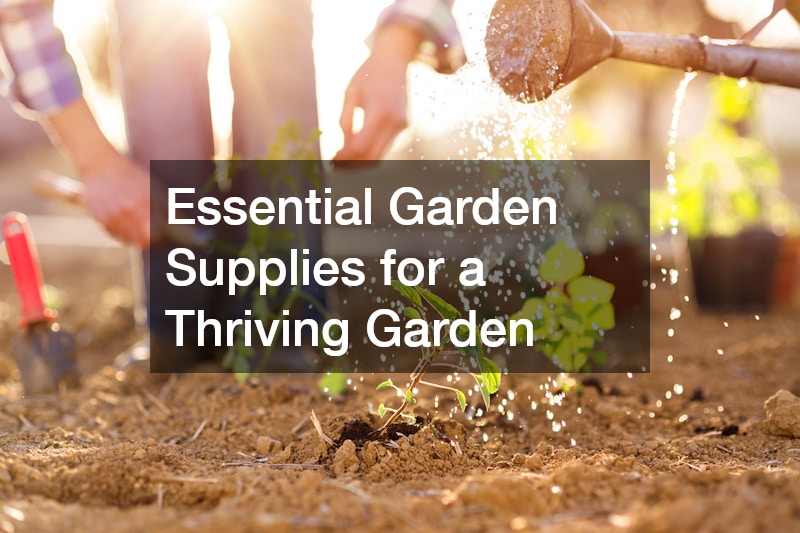Starting a garden can be a rewarding endeavor, providing you with beautiful plants and fresh produce. To ensure your garden thrives, it is essential to have the right supplies. This article explores the most common questions about essential garden supplies and provides a comprehensive guide to help your garden flourish.
What are Must-Have Tools for Beginner Gardeners?
Hand Tools
Hand tools are indispensable for any gardening project, whether you’re planting, weeding, or maintaining your garden. A quality trowel helps in transplanting small plants and bulbs, while a pruner keeps shrubs and trees in shape.
A cultivator is perfect for loosening soil and removing weeds, making it an essential addition to your gardening toolkit.
Moreover, choosing ergonomic hand tools can reduce strain and enhance your gardening experience. These tools are usually lightweight and designed with comfortable grips, ensuring that prolonged use doesn’t cause fatigue. By investing in a reliable set of hand tools, beginner gardeners set a solid foundation for successful gardening.
Additionally, maintaining your hand tools is crucial for their longevity. Regular cleaning prevents rust, and sharpening blades keeps them effective. Always store your tools in a dry place to avoid any deterioration and keep them ready for use.
Watering Equipment
Proper watering is pivotal for plant growth, and having the correct watering equipment ensures your plants remain hydrated. Hoses and watering cans come in various designs to fit different garden sizes and needs. A hose with an adjustable nozzle can control water flow, making it a versatile tool for watering larger areas.
In contrast, a watering can is ideal for targeted watering, ensuring each plant gets the necessary amount of water. For those wanting more automation, a drip irrigation system can be an excellent investment. By conserving water, these systems are efficient and support sustainable gardening practices.
Protective Gear
Gardening should be enjoyable and safe, necessitating the use of protective gear. Gloves are fundamental, offering protection against soil, thorns, and sharp tools. Choose durable gloves with a snug fit to prevent blisters and maintain dexterity while working.
Knee pads are another essential, especially for gardeners who spend considerable time kneeling. These pads cushion your knees, alleviating pressure and preventing discomfort during prolonged gardening sessions. In addition, wearing a wide-brimmed hat shields you from harmful UV rays, especially during long, sunny days.
Also, consider wearing breathable long-sleeve shirts to protect against scratches and insect bites. A sturdy pair of gardening boots shields your feet from mud and potential hazards. By investing in quality protective gear, you ensure that gardening remains a safe and comfortable endeavor.
How to Choose the Right Soil and Fertilizers?
Understanding Soil Types
The success of a thriving garden heavily relies on choosing the right soil type. Common soil varieties include clay, sandy, and loamy, each with unique characteristics. For instance, loamy soil is often preferred for its well-balanced texture, promoting root growth and water retention.
Determine your soil type by observing its texture and drainage capabilities. If you’re unsure, conducting a simple soil test can reveal crucial information about its nutrient and pH levels. Adjusting your gardening practices to accommodate your soil type can dramatically affect plant health and vitality.
Improving soil quality is possible by incorporating organic matter like compost or peat moss. These amendments break up compacted clay soils and enhance drainage in sandy soils. Regularly amending soil ensures your plants have the best growing environment, contributing to a lush garden.
Organic vs. Chemical Fertilizers
Fertilizers provide essential nutrients to plants, but choosing between organic and chemical fertilizers requires careful consideration. Organic fertilizers originate from natural sources, improving soil structure while feeding plants. They’re environmentally friendly but tend to release nutrients more slowly.
On the other hand, chemical fertilizers offer a more immediate nutrient boost and are easy to apply with specific nutrient ratios. However, overuse can cause nutrient runoff and long-term soil health issues. Balancing these factors helps you decide which fertilizer aligns with your gardening goals and sustainability philosophy.
Opt for a balanced approach by integrating organic matter with occasional chemical fertilizer use. This combination provides immediate and long-term nutrient availability. By evaluating the needs of your plants and the current soil condition, you can select the most effective fertilizer strategy.
By equipping yourself with the right tools, understanding soil types, and selecting suitable fertilizers, you can set up a thriving garden that will bring joy and productivity. Embrace these essential garden supplies to foster a green thumb and enjoy the fruits of your labor. Remember, a well-prepared garden is the foundation for successful growth, allowing your plants to thrive season after season.
.







